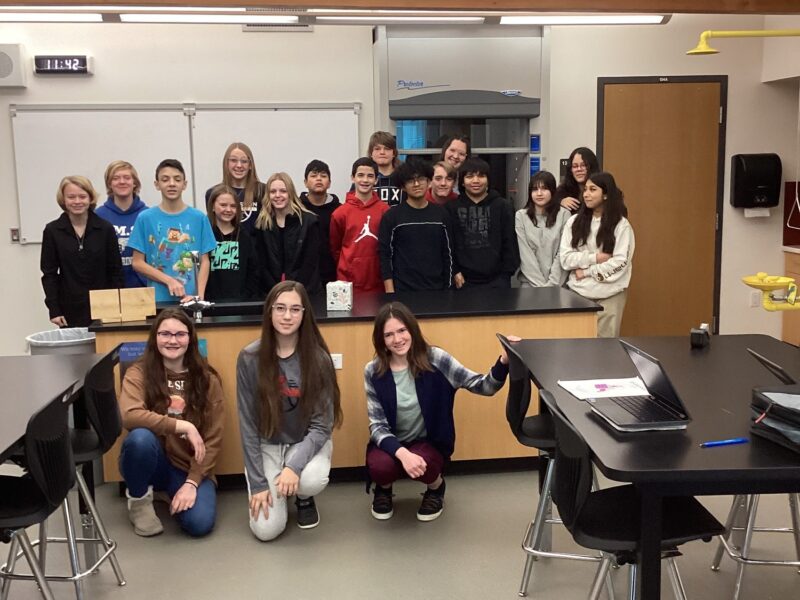Evanston 8th Graders Win National NASA Science Challenge
Team of students brainstorm how to feed people on Mars with “Seeds in Space” project
- Published In: Other News & Features
- Last Updated: Jan 29, 2023

Students in Ashley Graham's 8th grade science class at Evanston Middle School will send seeds into the stratosphere on a high-altitude balloon this summer as part of their winning entry in the NASA TechRise Student Challenge. (Courtesy photo from Ashley Graham)
By Elizabeth Sampson
Special to the Wyoming Truth
Students at Evanston Middle School are contemplating what people will eat on Mars.
Ashley Graham’s eighth graders recently learned they had created a winning entry in the NASA TechRise Student Challenge with their plan to see if they could control the conditions that seeds will experience in space.
The 21-student team is one of 60 winning entries in the NASA contest. Now in its second year, the TechRise Student Challenge is a STEM (science, technology, engineering and mathematics) competition that encourages students in 6th-12th grade to create experiments that can be tested on a suborbital flight. On the test flight this summer, a high-altitude hot-air balloon will ascend to 70,000 feet, carrying the students’ experiments for three to eight hours, where they will be exposed to the stratosphere’s thermal and atmospheric environment.
Graham’s students plan to send berry seeds inside a thermos up in the balloon to see if the seeds are protected against damage from UV radiation, heat, cold and other elements seeds might encounter on the trip from Earth to other planets. Graham said her students want to find a way to ensure pioneers on the moon or Mars can eventually start cultivating plants and have access to fresh food.
“I loved that they thought about the experiences we hope for in the future,” Graham said. “One of them was like, ‘Who wants to eat freeze dried food forever?’”
The Evanston project, called “Strong Seeds in Space,” will be on a balloon with 29 other student projects from around the country, while a second balloon will launch with the other 30 selected projects.
“The high-altitude balloon gives the students a lot of data to look at for how well their experiment worked and see how things work at different conditions on Earth that we cannot see in the classroom,” Graham said.
Each winning team receives a flight box and $1,500 to create their proposed experiment. Teams competed in several categories, including evaluating the effects of climate change; protecting humans, electronics, and various materials against radiation; testing machine learning and computing techniques for space technology; and supporting human health on long-duration space missions.
When her students learned their project had been selected, Graham said their reactions were typical of eight graders, running the gamut from being thrilled about what it could mean for their future to realizing they now have plenty of work to ready their experiment for launch day.
“We were shocked,” said eighth grader Remi W. “A few kids started crying, but getting to partner with NASA is huge.” (Graham asked that her students’ last names be withheld to protect their privacy because they are minors.)
Classmate Tycee M. agreed: “When I saw our name on the board, I was speechless. Working with NASA? Heck yeah!”
The class will spend 30 minutes each week from now until early May ordering their components, building their experiment and programming the instrumentation that will record data. As part of the project, the students will meet via Zoom with NASA engineers, representatives of the Future Engineers organization that administers TechRise and engineers from Aerostar, which is launching the balloon.
“NASA’s missions of tomorrow are sparked by the accomplishments of the Artemis Generation today in classrooms across America,” said NASA Administrator Bill Nelson in a statement. “Through opportunities like the TechRise Student Challenge, young people are deepening their passion in science and technology, preparing to be the future innovators and pioneers who help humanity soar to new heights and unlock more secrets of the universe.”
This is the first year Graham’s students entered the NASA TechRise Student Challenge, but she plans to have future students participate as well, saying it enables them to obtain real-world science experience.
Her students study earth and space in eighth grade, but more curriculum covers the earth portion, and this project allowed them to dive deeper into space studies. While their science textbook suggests a tsunami warning system science project, Graham didn’t think that would be a great fit for kids in Evanston.
“That’s not something they are going to deal with where we live in the middle of Wyoming,” Graham said.
On the other hand, space is a topic that has captivated her students.
“Here’s something we really will deal with in the future, and you get to be in on the ground floor before you’ve even graduated from high school—before you’ve even gone to high school,” Graham said. “You’re working with NASA and these engineers, and it’s giving you an opportunity to really experience what it’s like as a scientist as opposed to just what we do in school. This is thinking outside the box, looking beyond that, trying new things.”













